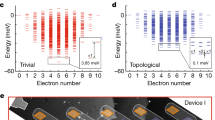Abstract
We have developed a code for the simulation of the electrical and magnetic properties of silicon quantum dots in the framework of the TCAD Package NANOTCAD-ViDES. We adopt current spin density functional theory with a local density approximation and with the effective mass approximation. We show that silicon quantum dots exhibit large variations of the total spin as the number of electrons in the dot and the applied magnetic field are varied. Such properties are mainly due to the silicon band structure, and make silicon quantum dots interesting systems for spintronic and quantum computing experiments.
Similar content being viewed by others
References
Friesen, M., et al.: Practical design and simulation of silicon-based quantum-dot qubits. Phys. Rev. B 67, 121301-1-4 (2003)
Ladd, T.D., et al.: All-silicon quantum computer. Phys. Rev. Lett. 89, 017901-1-4 (2002)
Friesen, M., Tahan, C., Joynt, R., Eriksson, M.A.: Spin readout and initialization in a semiconductor quantum dot. Phys. Rev. B 92, 037901-1-4 (2004)
Das Sarma, S., Fabian, J., Hu, X., Žutić, I.: Theoretical perspective on spintronics and spin-polarized transport. IEEE Trans. Magn. 36, 2821 (2000)
Pala, M.G., Governale, M., Kig, J., Zlicke, U., Iannaccone, G.: Two-dimensional hole precession in an all-semiconductor spin field effect transistor. Phys. Rev. B 69, 045304-1-9 (2004)
Rokhinson, L.P., Guo, L.J., Chou, S.Y., Tsui, D.C.: Spin transitions in a small Si quantum dot. Phys. Rev. B/ 63, 35321 (2000)
Reimann, S.M., Manninen, M.: Electronic structure of quantum dots. Rev. Mod. Phys. 74, 1325 (2002)
Koskinen, M., Kolehmainen, J., Reimann, S.M., Toivanen, J., Manninen, M.: Quantum dots in magnetic fields: Unrestricted symmetries in the current spin-density functional formalism. The Euro. Phys. J. D 9, 487–490 (1999)
Tanatar, B., Ceperley, D.M.: Ground state of the two-dimensional electron gas. Phys. Rev. B 39, 5005 (1989)
Pala, M.G., Iannaccone, G.: A three-dimensional solver of the Schrödinger equation in momentum space for the detailed simulation of nanostructures. Nanotechnology 13, 369–372 (2002)
Slater, J.C.: A simplification of the Hartree-Fock method. Phys. Rev. B 81, 385–390 (1951)
Author information
Authors and Affiliations
Corresponding author
Rights and permissions
About this article
Cite this article
Lisieri, M., Fiori, G. & Iannaccone, G. 3D simulation of a silicon quantum dot in a magnetic field based on current spin density functional theory. J Comput Electron 6, 191–194 (2007). https://doi.org/10.1007/s10825-006-0110-x
Published:
Issue Date:
DOI: https://doi.org/10.1007/s10825-006-0110-x




